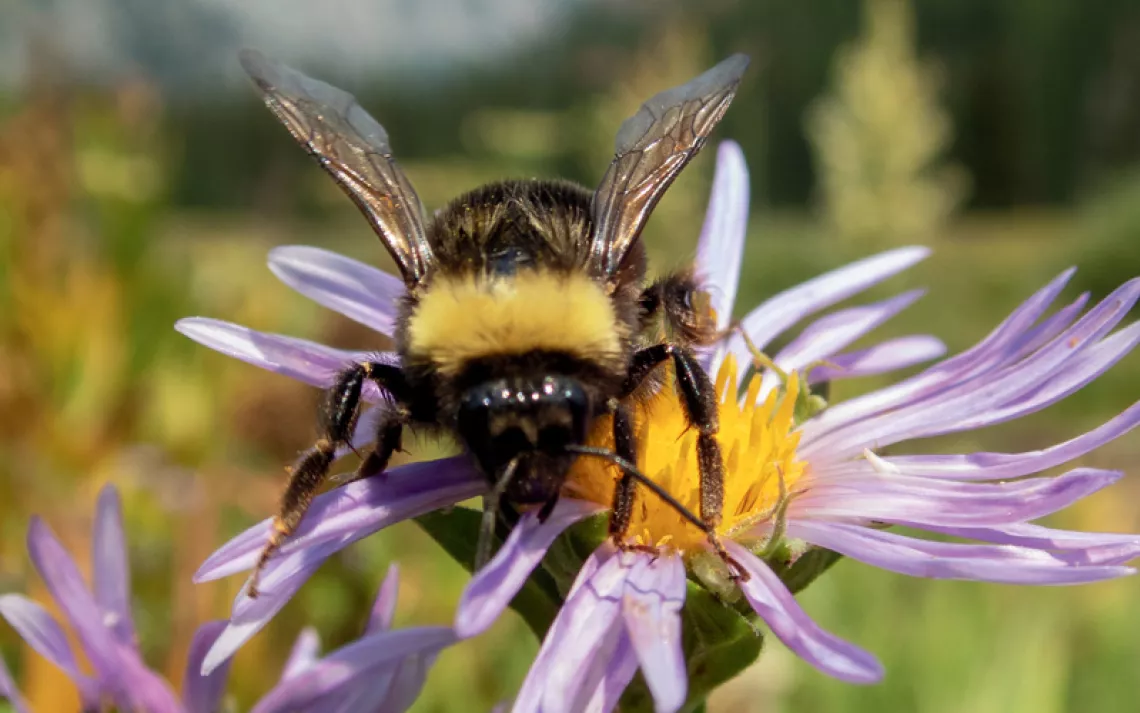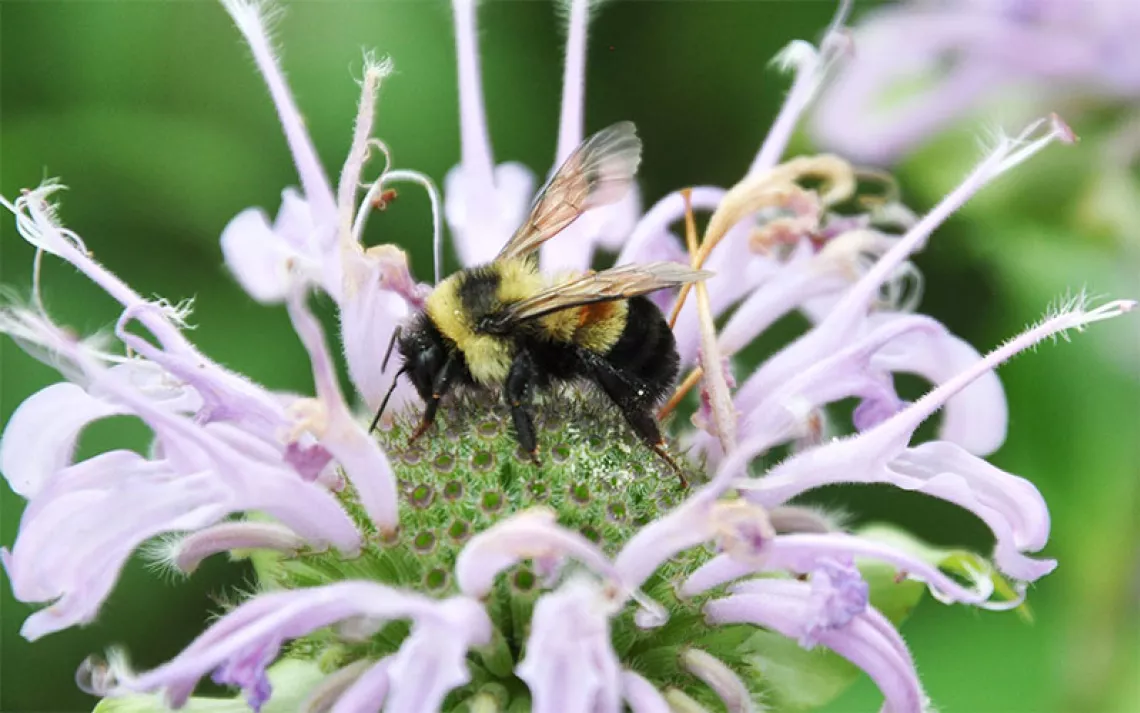Buzz Kill
As corn yields rise, bees are dying worldwide
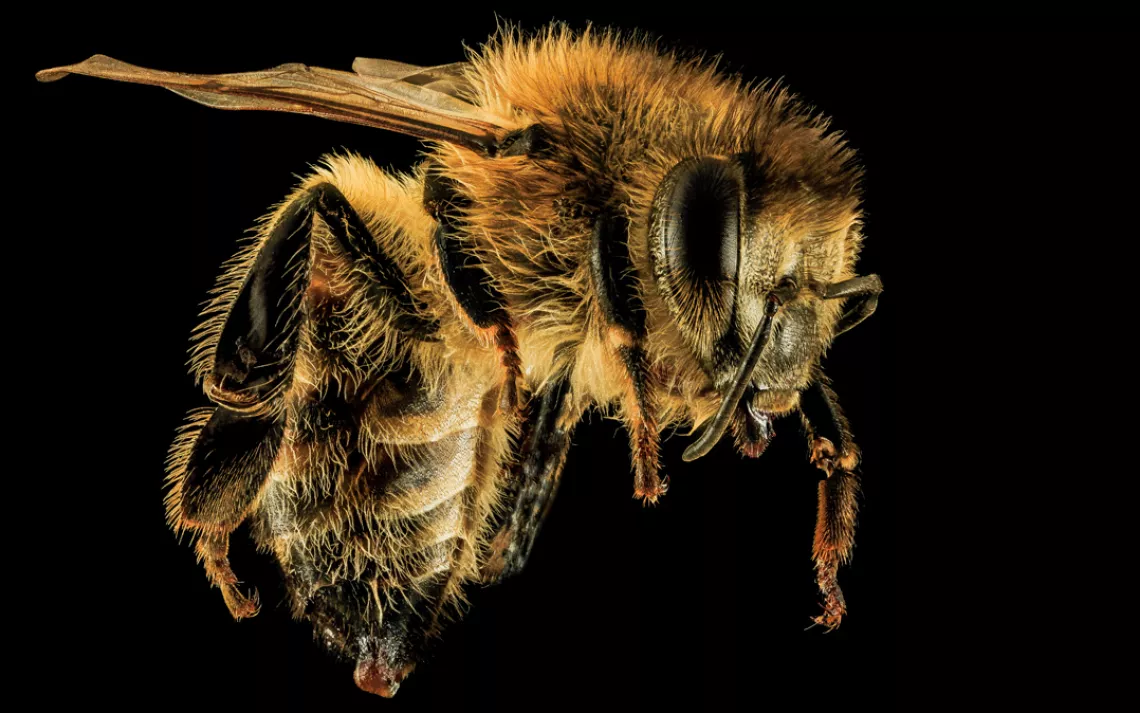
The Honey bee, Apis mellifera. | Photo courtesy of USGS/Bee Inventory and Monitoring Lab.
Not that long ago, third-generation commercial beekeeper Jim Doan was a prosperous man. He maintained as many as 5,300 hives on his farm in western New York. In addition to selling honey, he earned a good living renting out the services of his honeybees to pollinate crops such as butternut squash, zucchini, pumpkins, cucumbers, and apples.
But around 2006, Doan noticed that something was wrong with his bees. Whole colonies were simply disappearing, leaving behind empty hives. And in those colonies that remained in Doan's hives, the numbers were down, and they weren't making as much honey. He began losing half of his bees every year--something that he'd never seen in more than 40 years of beekeeping.
Doan knew that others around the country were having similar problems, and he heard that the cause might be poor beekeeping practices that allowed mite infestations. But testing of his hives showed low mite levels. He looked beyond his property to neighboring farms and realized there could be a different culprit. "There was corn all around my house," he recalled. "There's so much corn in western New York. Two golf courses have even been converted to cornfields."
It turned out that the stalks near Doan's farm had come from genetically engineered seeds treated with a class of neurotoxic pesticides called neonicotinoids. Applied to seeds, the pesticide spreads through plants as they grow, attacking the nervous systems of a wide range of pests, from corn rootworm to flea beetles. After they first hit the market in the early 1990s, neonicotinoids--basically, a synthetic form of nicotine that attacks receptors in insects' nervous systems--were hailed as a breakthrough replacement for previous generations of poisons. They not only worked against a wide array of insects but also could be used in smaller doses, which at least theoretically made them safer to use. Plus, they were much less expensive, allowing farmers to simply buy treated seeds rather than spray pesticides across massive fields.
But Doan began to see signs that the neonicotinoid-treated corn was killing more than pests. "When the corn pollen was out there in midsummer, I'd have piles of dead bees in front of the hives," he said.
Things got worse. In the spring and summer of 2012 and again in the spring of 2013, his colonies suffered devastating die-offs, which he believes were caused by the use of a neonicotinoid variant called clothianidin in neighboring cornfields. Less than 20 percent of his colonies remained, and his income plummeted. He sold his farm to settle his debts and came close to giving up beekeeping altogether.

A worker at Bill Rhodes Honey Company in Umatilla, Fla. uses a smoker to calm the bees before they're unloaded off of a semi truck. | Photo by Melissa Lyttle.
Since the mid-2000s, similar fates have befallen beekeepers across the United States. (See "Bye, Honey," below) Like Doan, many of them blame neonicotinoids, which are now applied to 90 percent of the corn and 30 percent of the soybeans grown in the country. They're also used on apples, rice, potatoes, sugar beets, and citrus fruits--and on about half of the plants sold in major garden stores.
Though their makers insist that neonicotinoids kill only pests when properly used, a growing number of studies suggest that chronic exposure to the neurotoxin endangers bees, birds, and other animals by disrupting their immune and nervous systems. Across the Atlantic, concern about the sudden spread of neonicotinoids prompted European Union officials to suspend most uses of the pesticide in 2013 while further research is conducted on its effect on bees.
To beekeepers' frustration, U.S. officials aren't moving with the same urgency. The EPA has opted to allow neonicotinoids to remain in use while it conducts reviews that won't be completed until as late as 2019, and legislation to impose a moratorium has stalled in Congress. Pesticide makers are mounting a sophisticated campaign to stave off restrictions, and neonicotinoid use is spreading. Many beekeepers, meanwhile, have stopped waiting for the feds and are taking action on their own to keep their bees alive.
In a desperation move, Doan moved most of his remaining hives and set up a new apiary near the Adirondack Mountains in 2013, far away from cornfields. His bees soon began flourishing again, and Doan has built his operation back to 1,000 hives. His bees still make honey, but he's no longer willing to risk leasing them out to farmers--a decision that costs him about $100,000 a year in lost income.
Other commercial beekeepers have also fled from farmlands. Steve Ellis, a Minnesota beekeeper, trucks his hives to the mountains of California during the corn-seeding time in his home state, out of fear that the bees will be poisoned by neonicotinoid-tainted dust from the fields. "Normally, that would be a great time to build the bees up, because that's when all the flowers are blooming in Minnesota," he said with frustration. "But what can you do?"
A U.S. Department of Agriculture-funded survey of 7,200 beekeepers found that they'd lost about 23 percent of their hives in the winter of 2013-14. Although the casualty rate was lower than that of the previous winter, most say that it's unsustainable, and Ellis and others note that the real situation is far worse than the numbers show, because they're now suffering losses year-round--something that was unheard of a few decades ago.
"I lose 10 percent in May, then in the fall I lose another 10 to 20 percent from the corn pollen, and then I go into the winter and lose another 30 percent," Ellis said. "Imagine if you were a dairy farmer and lost 60 percent of your cows every year. You'd be out of business pretty quick."
On top of that, Ellis noted, many of the surviving hives are stunted and sickly. "In the winter, your cluster should be the size of a basketball, or bigger," he said. "Instead, we're seeing a lot of ones that are softball- or baseball-size. Those bees will never pollinate a crop or produce honey. They're worse than a dead hive."
That could soon be a big problem when the rest of us go to the grocery store. Managed honeybees pollinate billions of dollars' worth of U.S. crops--including such mainstays as onions, almonds, oranges, and avocados. Chensheng Lu, an associate professor of environmental exposure biology at Harvard University's School of Public Health, said the threat is even deeper: "The detrimental effects of neonics are at the ecological scale."
While there's little dispute that honeybees are dying at unprecedented rates, pesticide makers and their political allies have insisted that neonicotinoids aren't to blame. Bayer CropScience, a subsidiary of German chemical-pharmaceutical giant Bayer and one of several neonicotinoid makers, argues that "numerous factors can negatively impact honeybee health--including parasitic mites, diseases, habitat loss, nutritional deficiencies, and hive management practices. Although some believe neonicotinoid insecticides may be involved, extensive research has shown that these products do not represent a long-term threat to bee colonies."
Over the past two decades neonicotinoids have come to account for about 30 percent of the global pesticide market, with more than $2.6 billion in sales, according to a 2010 trade journal article by Bayer scientists. Industry-backed studies claim that neonicotinoids improve corn yields by 17 percent compared with other pesticides. They "significantly contribute to the North American farm economy," says Bayer CropScience's website. Soybeans, however, are a different story: A 2014 EPA analysis concluded that soybean farmers have seen no increase in yield from using the pesticides.
When colony collapse disorder became a nationwide concern in the mid-2000s, most beekeepers and researchers initially figured that the problem was the varroa mite, a parasitic invader from Asia that had been spreading through the United States since the late 1970s, or that they were making some mistake in caring for their hives. "We knew what we were supposed to be doing, but it wasn't working," Pennsylvania beekeeper David Hackenberg recalled. "The bees were just vanishing."
Hackenberg said he started to put the pieces together after a former state apiary inspector told him that beekeepers in France, where neonicotinoids had been widely used since the mid-1990s, were complaining of something they called mad bee disease. Hackenberg contacted a beekeeper there, who told him of suspicions that the malady was connected to neonicotinoids. Then Hackenberg's wife found a study online that described the effects of a neonicotinoid on termites. "It was just like what was happening to bees," he recalled of the study's findings. "They couldn't navigate, and their immune systems started breaking down."
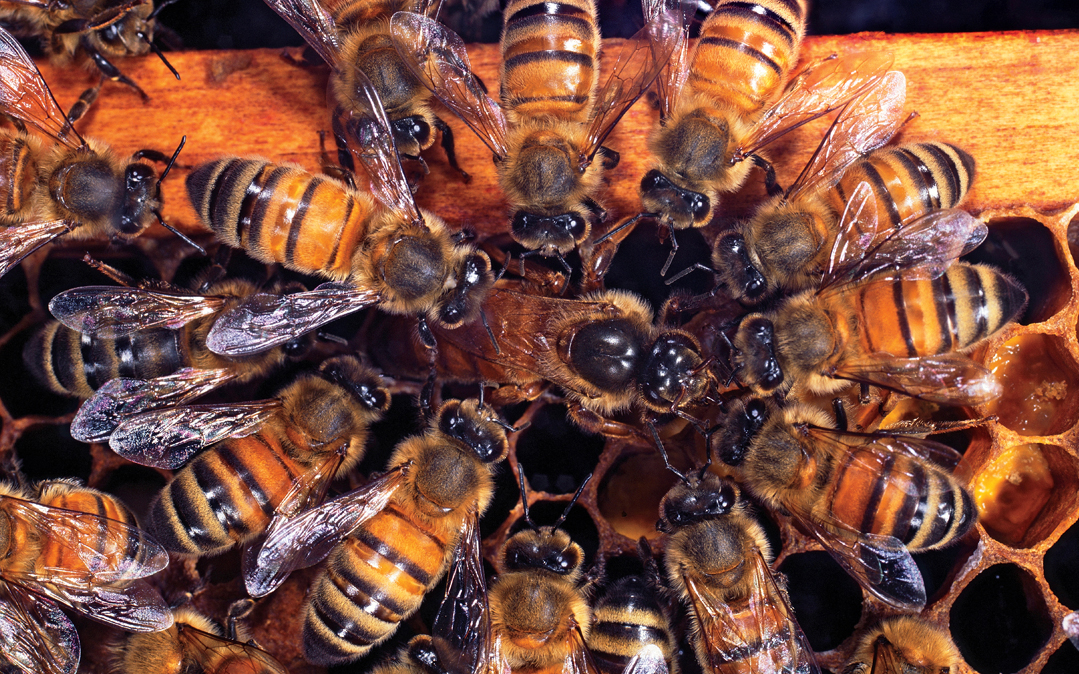
Honey Bee (Apis mellifera) workers mutual feeding within hive. Surrey, UK. | Photo by Kim Taylor/Nature Picture Library.
In the years since, numerous studies have bolstered Hackenberg's suspicions. Even at exposure levels that are too low to kill bees outright, neonicotinoids damage their nervous systems in ways that make it difficult to survive, researchers have found. One of the most provocative studies was published in 2012 by French researchers, who attached radio transmitters to the insects and observed them as they flew out of the hives to forage for food. After the bees were exposed to the neonicotinoid thiamethoxam, their navigational systems seemed to go haywire, and they were several times more likely to die before they could make their way back to the hive.
A pair of studies by British researchers, published in 2013, found that neonicotinoids, when combined with another pesticide used to kill mites, wreaked havoc with bees' neural circuitry, causing them to forget associations between the scents of flowers and food rewards.
A different study by South African scientists, published in PLOS ONE in 2014, concluded that neonicotinoids prevented the bees from retrieving the information they'd stored in their memories during exploratory flights. And a 2014 study by Brazilian researchers found that neonicotinoids were damaging bees at the cellular level, hindering them from generating the energy needed to contract their muscles and move their wings.
"The manufacturers want us to believe that the whole plant has been turned into a poison factory that'll kill every insect except bees," said Bill Rhodes, a Florida beekeeper who said he's been nearly bankrupted by bee die-offs. "The thing is, you don't have to physically kill the bee. You just have to impair him so he can't find his way back to the nest."
Faced with this flood of negative research, the pesticide industry has pushed back. Manufacturers routinely criticize the scientists' methods and cite more favorable research, such as a Bayer-funded survey of neonicotinoid studies published last year in Environmental Toxicology and Chemistry, which concluded that "such losses were unrelated to the patterns of agricultural pesticide use, in general, or neonicotinoid use, in particular."
One frequent industry counter has been that studies critical of neonicotinoids subject bees to doses far larger than what they actually experience in the real world. But that argument doesn't persuade James Frazier, a retired professor of entomology from Pennsylvania State University's College of Agricultural Sciences. "It's a favorite ploy of industry," he explained. "The truth is that no one really knows what the exposure is under field conditions."
In Frazier's view, the European Commission acted prudently when it banned the use of three important neonicotinoids: clothianidin, imidacloprid, and thiamethoxam. "One of the major differences between Europe and here is that the Europeans exercise the precautionary principle," he explained. "They say, 'We should not be using it unless we understand more about it.'"
A few days after Europe enacted its 2013 ban, the Department of Agriculture and the EPA issued a report concluding that although neonicotinoids were a "potential hazard" to bee health, they were still safer than previous types of pesticides. In a conference call with reporters, officials said there wasn't enough evidence to justify a ban. "There are meaningful benefits from these pesticides to farmers and consumers, as well as for affordable food," said Jim Jones, the EPA's top pesticide administrator.
Critics of the pesticides also complain that the EPA's system for tracking and investigating bee deaths potentially caused by neonicotinoids is hopelessly dysfunctional. Beekeepers can't report die-offs directly to the EPA and have them investigated. Instead, they have to go through state regulatory agencies--which, they say, are often reluctant to investigate to identify the chemical culprits--or else track down the pesticide manufacturer and ask the company to gather the information. "It's ridiculous," complained Ellis, who's dealt with the reporting system several times. "They're not getting the data because field incidents are not being reported and analyzed."
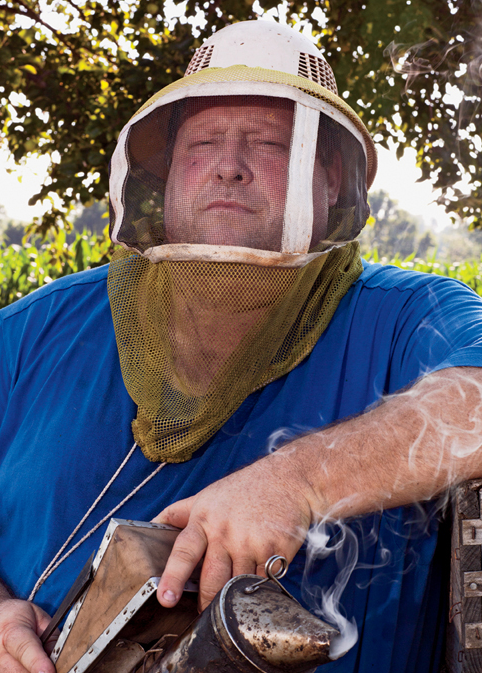
Beekeeper Jim Doan. | Photo by Hannah Whitaker/Hello Artists.
Frustrations with the EPA led various beekeepers to join the Sierra Club, the Center for Food Safety, the Pesticide Action Network, and other environmental organizations to file a federal suit in March 2013 to force the agency to suspend the registrations of clothianidin and thiamethoxam. Last year, a federal judge granted a motion by government attorneys to dismiss parts of the lawsuit; a decision on the suit's remaining claims is expected this spring.
In December, EPA official Marietta Echeverria revealed to a meeting of state pesticide regulators that the agency was considering some restrictions on neonicotinoids and other pesticides, such as barring their application during certain times of the day or year when pollinators are active. The agency said in an email to Sierra that it was "considering placing limitations on the application of all pesticides that are acutely toxic to bees," but that it had yet to make a decision on the move.
Additional studies now suggest that neonicotinoids may pose a risk to other animals as well--most notably birds, which can receive lethal doses if they eat seeds coated with the pesticide. A study published in Nature in 2014 found that insect-eating bird populations were declining in parts of the Netherlands where bodies of water have high concentrations of imidacloprid, apparently because the neonicotinoid was wiping out the insects that birds feed on.
"We're bathing the world in these chemicals," warns Cynthia Palmer of the American Bird Conservancy. "Birds, butterflies, possibly bats--they're all at risk."
The lack of a broad federal ban on neonicotinoids has activists looking for other ways to make an impact. The U.S. Fish and Wildlife Service's decided last year to phase out the use of neonicotinoids on national wildlife refuges by 2016, and environmental groups been urging the U.S. Forest Service to adopt similar bans on public lands that it controls. The Washington cities of Seattle and Spokane have joined Eugene, Oregon, in banning neonicotinoid use on public property.
Meanwhile, desperate beekeepers continue to practice evasive tactics. Steve Ellis still sequesters his bees in the mountains until he hears from his corn-farmer neighbors that they're done planting. But he knows that's not a sustainable solution. "Corn covers 200 million acres in this country, so it's hard to get away from," he said. "Bobbing and weaving is not really an option."
WHAT YOU CAN DO
Join the Sierra Club Grassroots Network's Pollinator Protection Campaign at sc.org/pollinator. Subscribe to the Club's biotech listserv by emailing lhopwood@roadrunner.
Bye, Honey
From 2000 to 2011, total annual honey production by bees in the United States fell one-third, from 221 million to 148 million pounds. In the same period, use of the three most common neonicotinoid pesticides (imidacloprid, thiamethoxam, and clothianidin) grew from about 280,000 to more than 4.5 million pounds domestically.--Stacey Hollis
 The Magazine of The Sierra Club
The Magazine of The Sierra Club


